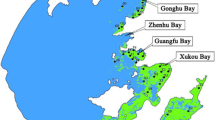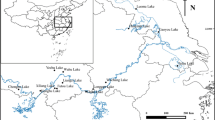Abstract
To improve the understanding of morphological and physiological changes of submerged macrophytes in response to different nutrient availabilities, Myriophyllum spicatum (a widely used lake restoration species due to its eutrophic tolerance in China) was planted in low-nutrient (TN 0.47 mg g−1, TP 0.10 mg g−1) and high-nutrient (TN 2.20 mg g−1, TP 1.91 mg g−1) sediments. The high-nutrient treatment reflected the eutrophication conditions in most lakes in the Middle and Lower Yangzi River Basin. Our results showed that the high nutrient level significantly increased the total biomass and affected shoot morphology traits; whereas the low sediment nutrient level significantly increased the root length of M. spicatum. The sediment nutrient enrichment significantly decreased the plant carbohydrate concentrations. Soluble sugar was positively correlated with the plant growth; however, carbohydrate concentrations in the auto-fragments only differed throughout its production period. It is noteworthy that most traits of M. spicatum respond rapidly between the treatments. These data demonstrate that M. spicatum can achieve a trade-off between its growth and storage by adjusting the pattern of biomass allocation in response to different sediment nutrients. Our study also implies that such flexible strategies would help M. spicatum adapt to the eutrophic environments.



Similar content being viewed by others
References
Adamec L (2010) Tissue mineral nutrient content in turions of aquatic plants: does it represent a storage function? Fundamental and Applied Limnology 176:145–151
Aiken SG, Newroth PR, Wile I (1979) The biology of Canadian weeds. 34. Myriophyllum spicatum L. Canadian Journal of Plant Science 59:201–215
Ali MM, Soltan MA (2006) Expansion of Myriophyllum spicatum (Eurasian water milfoil) into Lake Nasser, Egypt: invasive capacity and habitat stability. Aquatic Botany 84:239–244
Barko JW, Smart RM (1983) Effects of organic matter additions to sediment on the growth of aquatic plants. Journal of Ecology 71:161–175
Barko JW, Smart RM (1986) Sediment-related mechanisms of growth limitation in submersed macrophytes. Ecology 67:1328–1340
Barko JW, Adams MS, Clesceri NL (1986) Environmental factors and their consideration in the management of submersed aquatic vegetation: a review. Journal of Aquatic Plant Management 24:1–10
Barrat-Segretain MH (1996) Strategies of reproduction, dispersion, and competition in river plants: a review. Plant Ecology 123:13–37
Barrat-Segretain MH, Henry CP, Bornette G (1999) Regeneration and colonization of aquatic plants fragments in relation to the disturbance frequency of their habitat. Archiv Fur Hydrobiologie 145:111–127
Bonser SP, Aarssen LW (2003) Allometry and development in herbaceous plants: functional responses of meristem allocation to light and nutrient availability. American Journal of Botany 90:404–412
Boylen CD, Eichler LW, Madsen JD (1999) Loss of native aquatic plant species in a community dominated by Eurasian watermilfoil. Hydrobiologia 415:207–211
Buchan LAJ, Padilla DK (2000) Predicting the likelihood of Eurasian watermilfoil presence in lakes, a macrophyte monitoring tool. Ecological Applications 10:1442–1455
Cao T, Ni L, Xie P, Xu J, Zhang M (2011) Effects of moderate ammonium enrichment on three submersed macrophytes under contrasting light availability. Freshwater Biology 56:1620–1629
Cao J, Wang Y, Zhu Z (2012) Growth response of the submerged macrophyte Myriophyllum spicatum to sediment nutrient levels and water-level fluctuations. Aquatic Biology 17:295–303
Crossley MN, Dennison WC, Williams RR, Wearing AH (2002) The interaction of water flow and nutrients on aquatic plant growth. Hydrobiologia 489:63–70
Deng ZM, Chen XS, Xie YH, Li X, Pan Y, Li F (2013) Effects of size and vertical distribution of buds on sprouting and plant growth of the clonal emergent macrophyte Miscanthus sacchariflorus (Poaceae). Aquatic Botany 104:121–126
Dorken ME, Barrett SCH (2004) Phenotypic plasticity of vegetative and reproductive traits in monoecious and dioecious populations of Sagittaria latifolia (Alismataceae): a clonal aquatic plant. Journal of Ecology 92:32–44
Grace JB, Wetzel RG (1978) The production biology of Eurasian watermilfoil (Myriophyllum spicatum L.): a review. Journal of Aquatic Plant Management 16:1–11
Hajirezaei MR, Börnke F, Peisker M, Takahata Y, Lerchl J, Kirakosyan A, Sonnewald U (2003) Decreased sucrose content triggers starch breakdown and respiration in stored potato tubers (Solanum tuberosum). Journal of Experimental Botany 54:477–488
Hangelbroek HH, Santamaría L, de Boer T (2003) Local adaptation of the pondweed Potamogeton pectinatus to contrasting substrate types mediated by changes in propagule provisioning. Journal of Ecology 91:1081–1092
Hermans C, Hammond JP, White PJ, Verbruggen N (2006) How do plants respond to nutrient shortage by biomass allocation? Trends in Plant Science 11:610–617
Huber H, Chen X, Hendriks M, Keijsers D, Voesenek LACJ, Pierik R, Poorter H, de Kroon H, Visser EJW (2012) Plasticity as a plastic response: how submergence-induced leaf elongation in Rumex palustris depends on light and nutrient availability in its early life stage. New Phytologist 194:572–582
Karunagaran D, Ramakrishna Rao P (1991) Mode and control of starch mobilization during germination of seed of horse gram. Plant Science 73:155–159
Kautsky L (1988) Life strategies of aquatic soft bottom macrophytes. Oikos 53:126–135
Kimbel JC (1982) Factors influencing potential intralake colonization by Myriophyllum spicatum L. Aquatic Botany 14:295–307
Madsen JD (1997) Seasonal biomass and carbohydrate allocation in a southern population of Eurasian watermilfoil. Journal of Aquatic Plant Management 35:15–21
Madsen JD, Smith DH (1997) Vegetative spread of Eurasian Watermilfoil colonies. Journal of Aquatic Plant Management 35:63–68
McFarland DG, Barko JW, McCreary NJ (1992) Effects of sediment fertility and initial plant-density on growth of Hydrilla verticillata (LF) Royle and Potamogeton nodosus Poiret. Journal of Freshwater Ecology 7:191–200
Morris D (1948) Quantitative determination of carbohydrates with Dreywood’s anthrone reagent. Science 107:254–255
Murphy KJ, Rørslett B, Springuel I (1990) Strategy analysis of submerged lake macrophyte communities: an international example. Aquatic Botany 36:303–323
Niu YF, Chai RS, Jin GL, Wang H, Tang CX, Zhang YS (2013) Response of root architecture development to low phosphorus availability: a review. Annals of Botany 112:391–408
Pilon J, Santamaría L (2002) Clonal variation in morphological and physiological responses to irradiance and photoperiod for the aquatic angiosperm Potamogeton pectinatus. Journal of Ecology 90:859–870
Puijalon S, Lena J-P, Bornette G (2007) Interactive effects of nutrient and mechanical stresses on plant morphology. Annals of Botany 100:1297–1305
Puijalon S, Piola F, Bornette G (2008) Abiotic stresses increase plant regeneration ability. Evolutionary Ecology 22:493–506
Santamaría L (2002) Why are most aquatic plants widely distributed? Dispersal, clonal growth and small-scale heterogeneity in a stressful environment. Acta Oecologica 23:137–154
Sarneel JM (2012) The dispersal capacity of vegetative propagules of riparian fen species. Hydrobiologia 710:219–225
Smith CS, Barko JW (1990) Ecology of Eurasian watermilfoil. Journal of Aquatic Plant Management 28:55–64
Smith DH, Madsen JD, Dickson KL, Beitinger TL (2002) Nutrient effects on autofragmentation of Myriophyllum spicatum. Aquatic Botany 74:1–17
Spencer DF, Ksander GG (1996) Growth and carbon utilization by sprouted propagules of two species of submersed rooted aquatic plants grown in darkness. Hydrobiologia 317:69–78
Starand JA, Weisner SEB (2001) Morphological plastic responses to water depth and wave exposure in an aquatic plant (Myriophyllum spicatum). Journal of Ecology 89:166–175
Sugiyama S, Bazzaz FA (1998) Size dependence of reproductive allocation: the influence of resource availability, competition and genetic identity. Functional Ecology 12:280–288
Suzuki JI, Stuefer JF (1999) On the ecological and evolutionary significance of storage in clonal plants. Plant Species Biology 14:11–17
Titus JE, Adams MS (1979) Comparative carbohydrate storage and utilization patterns in the submersed macrophytes, Myriophyllum spicatum and Vallisneria americana. American Midland Naturalist 102:263–272
Vojtíšková L, Munzarová E, Votrubová O, Čížková H, Lipavská H (2006) The influence of nitrogen nutrition on the carbohydrate and nitrogen status of emergent macrophyte Acorus calamus L. Hydrobiologia 563:73–85
Wang J, Yu D (2007) Influence of sediment fertility on morphological variability of Vallisneria spiralis L. Aquatic Botany 87:127–133
Weber JA, Noodén LD (2005) The causes of sinking and floating in turions of Myriophyllum verticillatum. Aquatic Botany 83:219–226
Xiao K, Yu D, Wang J (2006) Habitat selection in spatially heterogeneous environments: a test of foraging behaviour in the clonal submerged macrophyte Vallisneria spiralis. Freshwater Biology 51:1552–1559
Xie D, Yu D (2011a) Size-related auto-fragment production and carbohydrate storage in auto-fragment of Myriophyllum spicatum L. in response to sediment nutrient and plant density. Hydrobiologia 658:221–231
Xie D, Yu D (2011b) Turion production and nutrient reserves in Potamogeton crispus are influenced by sediment nutrient level. Aquatic Biology 14:21–28
Xie Y, Wen M, Yu D, Li Y (2004) Growth and resource allocation of water hyacinth as affected by gradually increasing nutrient concentrations. Aquatic Botany 79:257–266
Xie Y, An S, Yao X, Xiao K, Zhang C (2005) Short-time response in root morphology of Vallisneria natans to sediment type and water-column nutrient. Aquatic Botany 81:85–96
Xie Y, Luo W, Ren B, Li F (2007) Morphological and physiological responses to sediment type and light availability in roots of the submerged plant Myriophyllum spicatum. Annals of Botany 100:1517–1523
Xie D, Yu D, Yu LF, Liu CH (2010) Asexual propagations of introduced exotic macrophytes Elodea nuttallii, Myriophyllum aquaticum, and M. propinquum are improved by nutrient-rich sediments in China. Hydrobiologia 655:37–47
Xie D, Yu D, You WH, Xia CX (2013) The propagule supply, litter layers and canopy shade in the littoral community influence the establishment and growth of Myriophyllum aquaticum. Biological Invasions 15:113–123
Yang Y, Yu D, Li Y, Xie Y, Geng X (2004) Phenotypic plasticity of two submersed plants in response to flooding. Journal of Freshwater Ecology 19:69–76
Ye C, Yu H, Kong H, Song X, Zou G, Xu Q, Liu J (2009) Community collocation of four submerged macrophytes on two kinds of sediments in Lake Taihu, China. Ecological Engineering 35:1656–1663
Yu LF, Yu D (2009) Responses of the threatened aquatic plant Ottelia alismoides to water level fluctuations. Fundamental and Applied Limnology 174:295–300
Zhang X, Liu X, Ding Q (2012) Morphological responses to water-level fluctuations of two submerged macrophytes, Myriophyllum spicatum and Hydrilla verticillata. Journal of Plant Ecology
Acknowledgments
We thank Wen Xiong, Yuqin Han, Keyan Xiao and Manghui Tu for laboratory/field assistance and helpful discussions. We also greatly appreciate two anonymous reviewers for valuable comments on an early version of the manuscript. This research was supported by the National Natural Science Foundation of China (30930011).
Author information
Authors and Affiliations
Corresponding author
Rights and permissions
About this article
Cite this article
Xie, D., Yu, D., You, WH. et al. Morphological and Physiological Responses to Sediment Nutrients in the Submerged Macrophyte Myriophyllum spicatum . Wetlands 33, 1095–1102 (2013). https://doi.org/10.1007/s13157-013-0465-2
Received:
Accepted:
Published:
Issue Date:
DOI: https://doi.org/10.1007/s13157-013-0465-2




